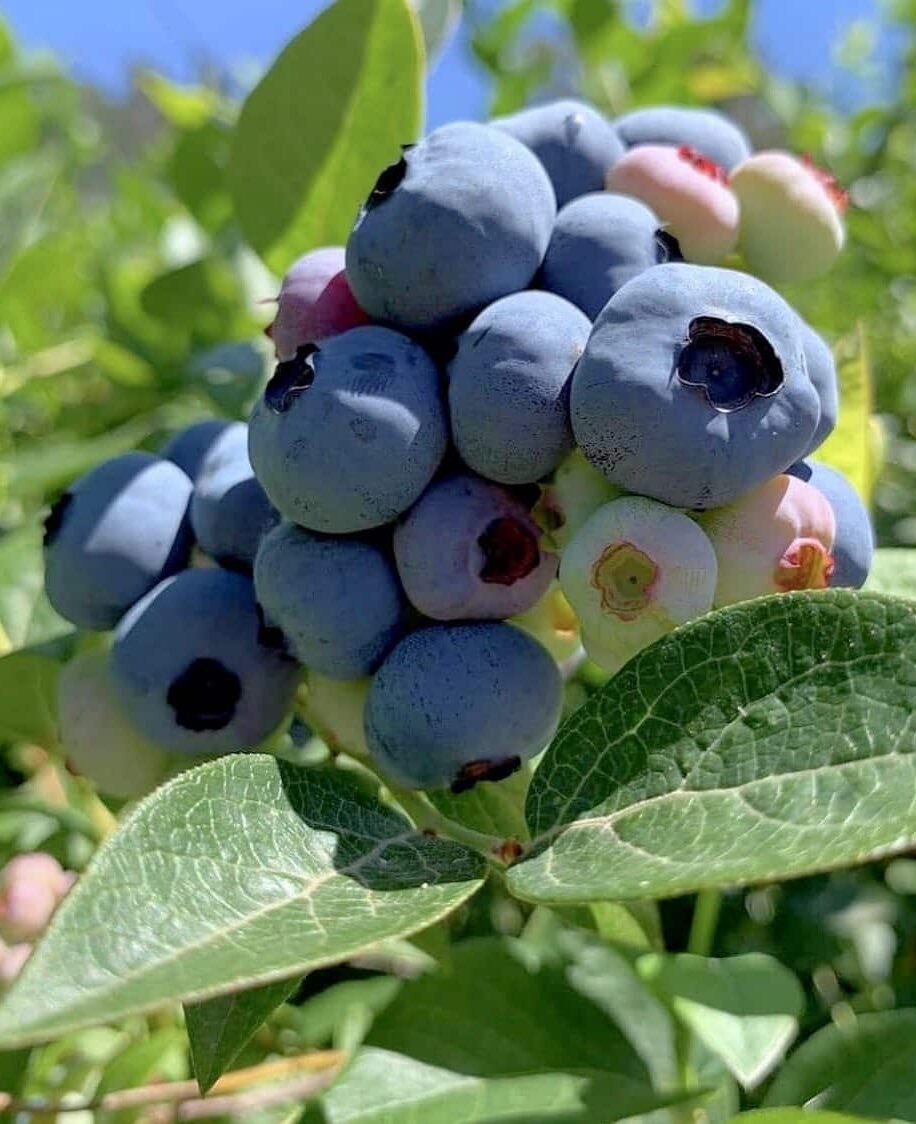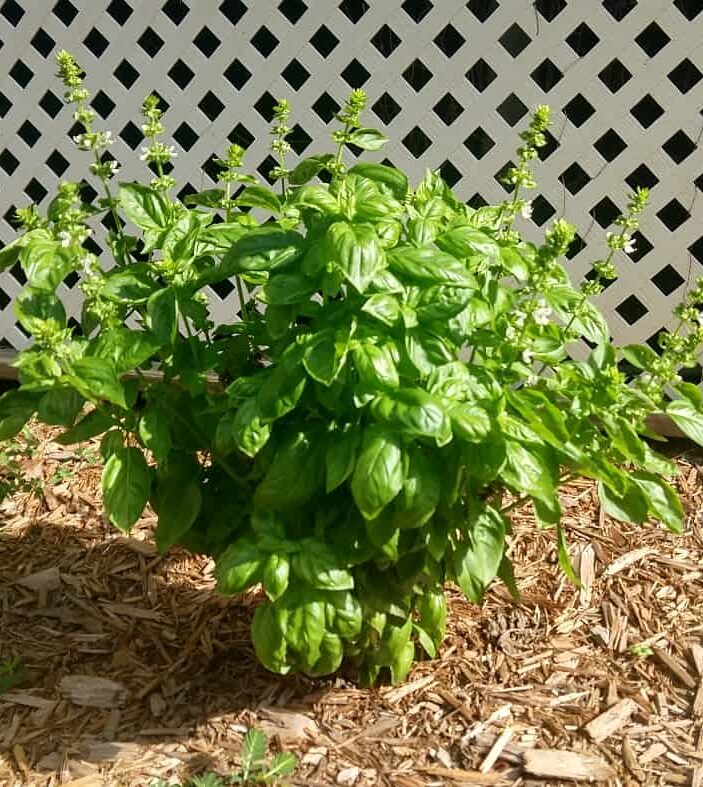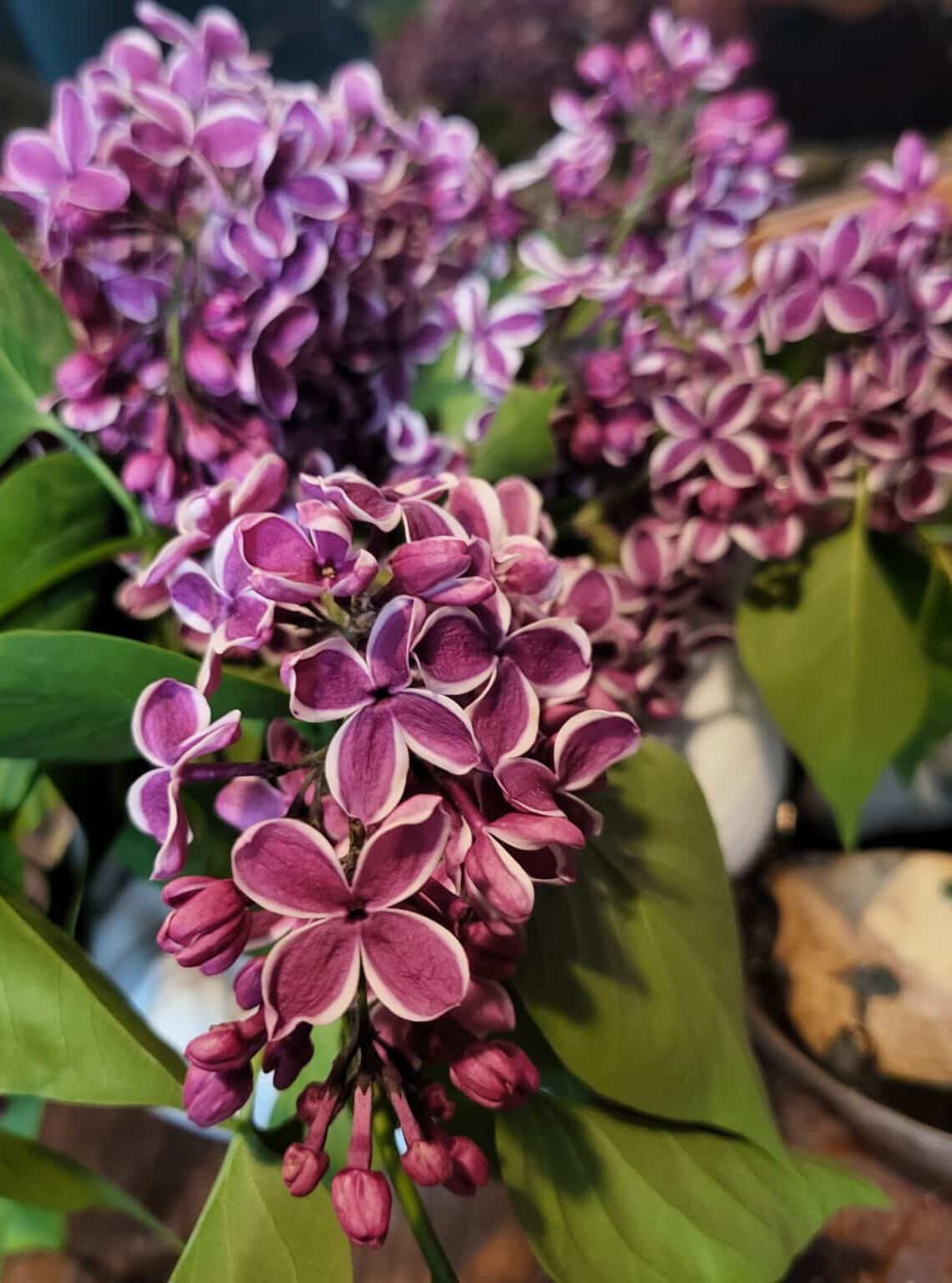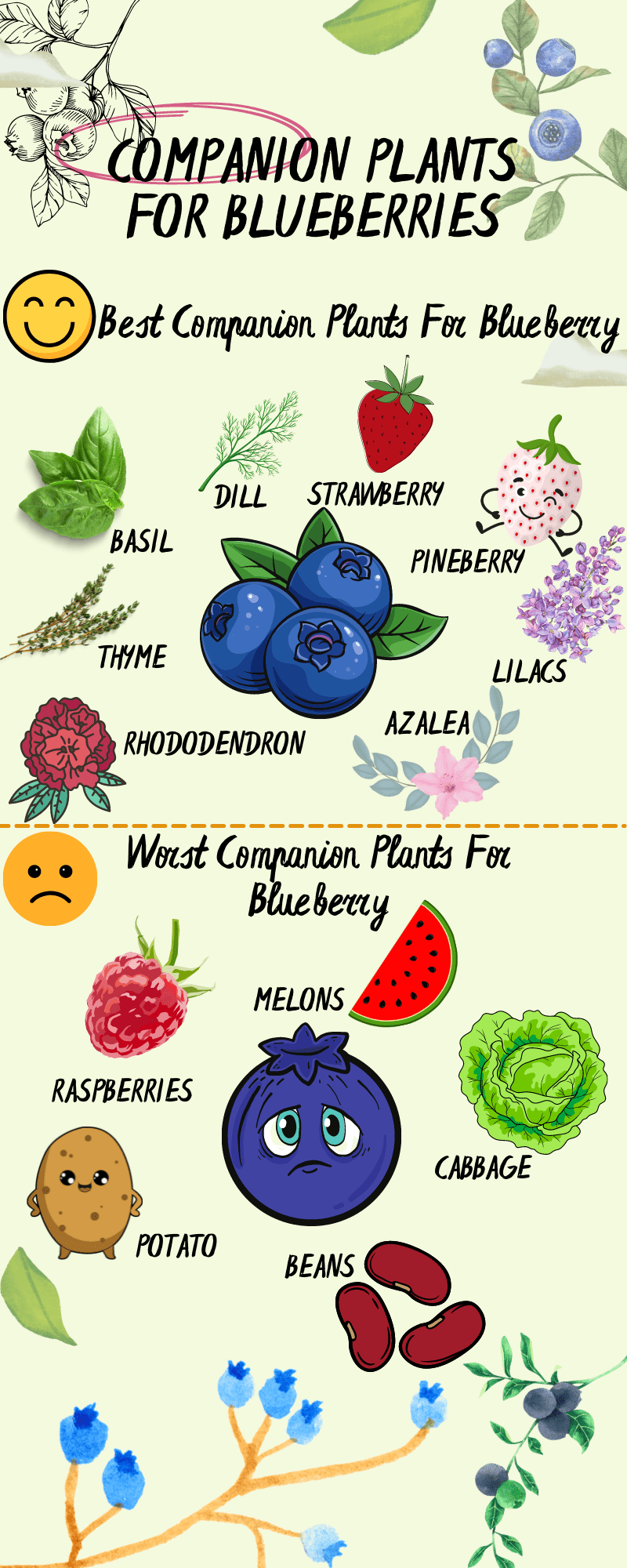Usually, people plant two Blueberry bushes as neighbors for more yield, but do you know they can be great garden companions with other plants too?
Read on (and obviously do not skip any section) to know what to plant with Blueberries and bad companion plants for Blueberries.
Table of Contents
Why Does Blueberry Need Companion Plants?
I won’t have to replant them yearly to savor their fruits, thanks to Blueberry’s perennial nature.
Blueberries can live happily for about 50 years because that is how long these plants live.
We are here to learn how to leverage companion planting for Blueberries.
Repelling Insects and Pests
Since I started planting Blueberries, my sole aim has been growing a healthy batch. But, the little pests walked all over my dreams.
After that, a friend recommended I plant some herbs like basil and thyme around my plant.
And to my wonder, certain herbs serve as the best companion plants for my Blueberry. They can successfully repel insects and pests such as flies and mosquitoes.
Attract Pollinating Insects
You may be fascinated by the Blueberries that look and taste good, but have you looked at their flowers?
I literally gasped when I looked at these small white-pink flowers. These flowers are small but carry the capacity to produce pollens that aid in continuing their lineage.

These flowers are enough to attract a few pollinators. I put my experiment suit on a few months ago and planted flowering plants with beautiful blooms around my Blueberry.
Now the number of common pollinators has increased five-fold! Thanks to those azaleas and lilacs.
Improve Soil Nutrition
This is one of the sectors I have focused on most while caring for my Blueberries. This goes without saying that soil nutrition is integral to growing plants.
I was lucky to plant a bush bean near my Blueberry, only to find out later that it adds nutrients, including nitrogen, to the soil.
Now I have tasty beans and cute little healthy Blueberries I can munch on. It’s a win-win game!
Offer the Needed Shade
A thought crossed my mind as I walked on with an umbrella in my hand to protect myself from the intense sun.
My Blueberry may also need protection from intense sun rays, so as a plant parent, what can I do?
So, I used my common sense and planted a tall plant (zucchini) near my plant to provide shade. Oh, how proud of me my plant must be.
9 Suitable Blueberry Companion Plants For Your Garden
While journeying for the best Blueberry bush companion plants, I confirmed if they provide the above benefits.
While Blueberry requires full bright sunlight for about 8 hours a day and acidic soil to thrive, I chose plants that can flourish under those conditions.
Below, I’ll show you some plants you can grow around your Blueberry as their companion plants.
1. Herb Plants
I planted herbs around my Blueberries to stop certain pests from attacking the plant. Now, I have a garden of pretty Blueberries and beneficial herbs.

You can also replicate me if you consider planting the following herbs around your plant, indirectly letting your Blueberry flourish.
Thyme
Like the Blueberry plant, thymes can do good in acidic soil, with thyme being able to tolerate the soil on a bit alkaline side.
I planted thyme near my Blueberry plant, and to my wonder, this low-maintenance plant also turned out to be perennial.
On top of that, the thyme plant also provided a ground cover for my Blueberry plant.
Basil
Aside from the many medical benefits of basil, the plant is also a beneficial companion plant for your Blueberry.
Its acidic soil preference and the fresh smell that repels pests make it a perfect addition to your Blueberry periphery.
Dill
Dill is another herb that I planted near my Blueberry to leverage the benefits.
Its soil preference is similar to my Blueberry; it likes acidic soil, and the sunlight requirements of 6-8 hours of direct sun are identical.
Beneficial insects like ladybugs also hovered around my dill plant, so pollination for my Blueberry became easier.
Other herbs you can experiment on are borage and parsley.
2. Edible Fruits and Vegetable Plants
Blueberry is already a tasty fruit to grow in your garden; imagine growing many other fruits around it without any harm.

Thanks to their similar growth requirements, I could grow some edible plants around my Blueberry plant.
Strawberry
My happiness knew no bounds when I learned I could plant a strawberry near my Blueberry. Imagine having two tasty fruits in your garden!
Back to reality, many people wonder if they can grow their strawberries and Blueberries together. The answer is yes.
Both plants require similar acidic soil to grow, and the red berry keeps your Blueberry safe by preventing weeds from growing.
Try it; strawberries and Blueberries make great companion plants together.
Pineberry
The more I think about planting these fruits with my Blueberries, the more excited I get.
Who wouldn’t want to fill their garden with tasty fruits like Pineberries? You certainly need not even think of it once.
And the best part? Pineberry and Blueberry share similar soil and condition requirements.
Cover Crops
Cover plants are crops that boost soil nutrients, contain weeds and wild grasses, and also repel pests.
Well, I certainly wanted my Blueberry companions to provide the above features. So, I planted cover crops like clover, peanuts, peas, and soybeans around them.
On top of that, these plants also provided my plant with good cover from the harshest weather.
So, you need to plant cover crops if you want healthy Blueberries.
Other fruits and vegetables you can try are cranberries, potatoes, etc.
3. Ornamental Flower Plants
I always wanted my garden to awe anybody who passed by it. I had to plant beautiful flowers in my garden to make that possible.

While choosing the flowers, I considered the ones that posed no threat to my Blueberry and helped it grow.
So, I have the following flowers to improve the aesthetic of my garden.
Lilacs
Can you smell that sweet fragrance? Those are the lilacs that I planted as companions to my Blueberry.
The lilacs are the better cover plants for bigger gardens. Thanks to their color and smell, they are very helpful in attracting pollinators.
These beautiful flowers can also thrive in acidic soil like Blueberries.
Rhododendron
Like Blueberries, rhododendrons thrive in sunny weather and acidic soil. What else makes rhododendron better companion plants for Blueberries?
First, rhododendron has beautiful blossoms; second, they can be bushy, offering shade for my Blueberries.
What more? Both the beautiful plants’ hail from the same family, Heaths, indicating similar growing and caring requirements.
Azalea
Imagine your Blueberries surrounded by these colorful azaleas. A sight to behold, right?
That’s what I thought when I planted an azalea near my Blueberry. As a bonus, azalea and Blueberry share a similar acidic soil.
Plus, azaleas provide beautiful flowers, while Blueberry offers tasty fruits.
Permaculture of Blueberry Companion Plants
To sustainably utilize Blueberries in permaculture, you must plant their seedlings in justifiable spacing.
Hence, grow Blackberry bushes by planting their seedlings in 24 inches deep and 1.5 feet wide spots. Mind at least 5-10 feet wide gaps between the plants.
Some Bad Companion Plants For Blueberries
I talked about how I took benefits from certain plants around my Blueberries, but to gain that experience, I had to experiment a lot.
As I was not the Picasso of gardening initially, I also had a few failed experiments.
But don’t worry; I am here to prevent you from committing the same mistakes I did.
You must avoid the following plants as companions for your Blueberries if you don’t want to share my fate.
| Bad Companion Plants | Why are They Bad? |
|---|---|
| Raspberries | Growth habit is different Need only mildly acidic, around 6.0 |
| Melons | pH requirement is high ( 6.0-6.7). |
| Cabbage and Cauliflowers | Need heavy nutrient requirements including nutrients |
| Tomato, Potato and Eggplants | These plants need soil with higher pH (5.5-7.5). |
| Beans and Peas | Require a high pH (5.8-6.5) for survival Attract pest |
| Tuberous Vegetables | Attract pests (ants, beetles, boxelder bugs) and diseases (bacterial leaf spot, rust, downy mildew) |
Proven Tips for Better Companion Planting for Blueberries
Even after you have chosen the perfect companion plants for your garden, you need to keep a few things in mind to be truly successful.
Based on my experience and research, you must strictly follow the following to see your Blueberry and its companions flourish.
- Keep a distance of at least 3 feet between the plants.
- Water an inch or two every week when the plant grows and 3-4 inches weekly when they produce flowers and fruits.

- Ensure the soil stays acidic, so you check its pH occasionally.
- Choose a location where the plants can stay in full sun for 6-7 hours daily.
- Check the plants frequently for signs of pests and diseases to prevent disaster.
- Make sure you do not plant tall trees around your Blueberry plant, as they can hinder the light for blueberries.
From Editorial Team
Conclusion!
Thanks to my intensive research and experiments, I could yield better Blueberries.
Now I have tasty fruit loaded with benefits.
Read the above sections carefully; you can reap what I am leveraging now.
Also, make sure to keep me updated about your progress in the comment section below.
Happy Gardening!


